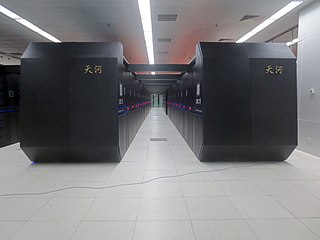SiCortex was a supercomputer manufacturer founded in 2003 and headquartered in Clock Tower Place, Maynard, Massachusetts. On 27 May 2009, HPCwire reported that the company had shut down its operations, laid off most of its staff, and is seeking a buyer for its assets. [1] The Register reported that Gerbsman Partners was hired to sell SiCortex's intellectual properties. [2] While SiCortex had some sales, selling at least 75 prototype supercomputers to several large customers, the company had never produced an operating profit and ran out of venture capital. New funding could not be found.

A supercomputer is a computer with a high level of performance compared to a general-purpose computer. The performance of a supercomputer is commonly measured in floating-point operations per second (FLOPS) instead of million instructions per second (MIPS). Since 2017, there are supercomputers which can perform up to nearly a hundred quadrillion FLOPS. Since November 2017, all of the world's fastest 500 supercomputers run Linux-based operating systems. Additional research is being conducted in China, the United States, the European Union, Taiwan and Japan to build even faster, more powerful and more technologically superior exascale supercomputers.

Maynard is a small suburban town in Middlesex County, Massachusetts, United States. The town is located 22 miles west of Boston, in the MetroWest and Greater Boston region of Massachusetts and borders Acton, Concord, Stow and Sudbury. As of the 2010 census, the town population was 10,106.

The Register is a British technology news and opinion website co-founded in 1994 by Mike Magee, John Lettice and Ross Alderson. Situation Publishing Ltd is listed as the site's publisher. Drew Cullen is an owner, Linus Birtles the managing director and Andrew Orlowski is the Executive Editor.
Contents
The company built and marketed a family of clusters of between 12 and 972 compute nodes, connected in a Kautz graph. The clusters are the SC5832, SC648 and SC072. It was reported that the company has been working on the next generation of clusters since March 2009, but development ceased when operations were closed.

The Kautz graph is a directed graph of degree and dimension , which has vertices labeled by all possible strings of length which are composed of characters chosen from an alphabet containing distinct symbols, subject to the condition that adjacent characters in the string cannot be equal.
The SC5832 is a high-end model housed in a cabinet. It has 972 nodes, 5,832 cores and 972 to 7,776 GB of memory. It uses a diameter-6 Kautz graph for 2,916 links. The SC648 is a mid-range model housed in a standard 19-inch rack. Each rack may contain two systems. It has 108 nodes, 648 cores and 108 to 864 GB of memory. It uses a diameter-4 Kautz graph for 324 links. The SC072 is a desktop model for developing software.
Each node is system-on-chip (SoC), codenamed ICE9, [3] consisting of six cores that implement the MIPS64 instruction set architecture (ISA). Each core has a 32 KB instruction cache and a 32 KB data cache. The six cores have their own 256 KB L2 cache, which can be accessed by other cores. The MIPS cores execute instructions in-order and have a six-stage pipeline. They can issue and execute two instructions per cycle for peak double-precision (64-bit) performance of 1 GFLOPS at 500 MHz. This was later increased to 1.4 GFLOPS when the clock frequency of the SoC was increased to 700 MHz when the SoC was fabricated in a 90 nm process. The SoC contains two DDR2 memory controllers, each controlling a single DIMM. Each node can have 1 to 8 GB of memory. The SoC also implements a 8x PCI Express controller. The cluster interconnect is implemented by a DMA engine fabric switch. Each cluster interconnect provides a maximum bandwidth of 2 GB/s.

A multi-core processor is a single computing component with two or more independent processing units called cores, which read and execute program instructions. The instructions are ordinary CPU instructions but the single processor can run multiple instructions on separate cores at the same time, increasing overall speed for programs amenable to parallel computing. Manufacturers typically integrate the cores onto a single integrated circuit die or onto multiple dies in a single chip package. The microprocessors currently used in almost all personal computers are multi-core.
MIPS is a reduced instruction set computer (RISC) instruction set architecture (ISA) developed by MIPS Computer Systems.
An instruction set architecture (ISA) is an abstract model of a computer. It is also referred to as architecture or computer architecture. A realization of an ISA is called an implementation. An ISA permits multiple implementations that may vary in performance, physical size, and monetary cost ; because the ISA serves as the interface between software and hardware. Software that has been written for an ISA can run on different implementations of the same ISA. This has enabled binary compatibility between different generations of computers to be easily achieved, and the development of computer families. Both of these developments have helped to lower the cost of computers and to increase their applicability. For these reasons, the ISA is one of the most important abstractions in computing today.
Message passing, via MPI, is the presumptive programming model. SiCortex systems run a customized Linux distribution derived from Gentoo Linux.
Message Passing Interface (MPI) is a standardized and portable message-passing standard designed by a group of researchers from academia and industry to function on a wide variety of parallel computing architectures. The standard defines the syntax and semantics of a core of library routines useful to a wide range of users writing portable message-passing programs in C, C++, and Fortran. There are several well-tested and efficient implementations of MPI, many of which are open-source or in the public domain. These fostered the development of a parallel software industry, and encouraged development of portable and scalable large-scale parallel applications.

Linux is a family of free and open-source software operating systems based on the Linux kernel, an operating system kernel first released on September 17, 1991 by Linus Torvalds. Linux is typically packaged in a Linux distribution.
Gentoo Linux is a Linux distribution built using the Portage package management system. Unlike a binary software distribution, the source code is compiled locally according to the user's preferences and is often optimized for the specific type of computer. Precompiled binaries are available for some larger packages or those with no available source code.



